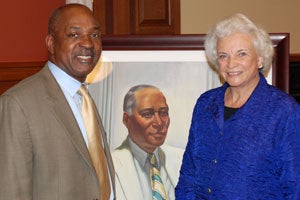Not enough progress has been made toward racial equality in education, said former Supreme Court Justice Sandra Day O’Connor at Harvard Law School last week. She called for the continuation of race-based affirmative action, in her keynote address at the Charles Hamilton Houston Institute’s conference, “Charting New Pathways to Participation & Membership.”
In 2003, O’Connor penned the influential majority opinions in the Court’s Gratz and Grutter cases, which addressed the use of affirmative action in admissions policies for the University of Michigan’s undergraduate and law school programs.
Reflecting on those decisions, she noted that the Court relied heavily on the precedent set in the 1978 landmark decision on affirmative action in Regents of the University of California v. Bakke. There, Justice Lewis Powell wrote that racial diversity could be a legitimate factor in university admissions as long as it wasn’t the only type of diversity to be considered.
In Gratz v. Bollinger, the Court ruled that the University of Michigan’s point system for considering race was unconstitutional because it was too restrictive. Grutter v. Bollinger was decided differently, however. Citing Bakke, the Court noted that the University of Michigan Law School’s policy of taking race into account as just one among several factors was constitutional.
O’Connor went on to say that the Court did not expect the decision in the Grutter case to be permanent jurisprudence, but rather a temporary bandage for a problem that would soon be repaired. But, she said, “In today’s America, I’m inclined to think that race still matters in painful ways.”
In the time since the Gratz and Grutter decisions were handed down, O’Connor said, there has not been enough attention given to the issue of diversity in education. “I frankly haven’t seen enormous changes in this country in the last five years,” she said.
O’Connor discussed state constitutional changes that have put up barriers to state universities using race-based affirmative action policies. California and Washington, among other states, have adopted laws that O’Connor said have not helped minorities get into top schools in those states.
She also cited statistics indicating the large gap between the numbers of black males versus white males in prisons. More black men have emerged from prison than have graduated from high school, she said.
O’Connor emphasized the importance of greater equality in education. Good education must be available to students of every race, she said, so they can get better jobs after school.
Moreover, she said, more focus needs to be placed on teaching children early on about ethnic diversity. “Everyone benefits from learning how to interact and understand people from different backgrounds and races.”
She urged the audience—and the nation—to think about how to make policy changes improving childhood education so that children can better understand racial differences.
“Growing up on a cattle ranch, as I did, I learned that if you can round up a bunch of cranky, old cows and move them from one place to another, you can darn sure round up a few votes in Congress,” she said.
Introducing O’Connor, Dean Elena Kagan ’86 cited her frequent swing votes on the Court. As a result, said Kagan, O’Connor ended up creating constitutional law on a whole range of issues.
“Justice O’Connor, in her 24 years on the court, had perfect pitch,” said Kagan. “Our constitutional system, and our country, was in the best of hands, even, or perhaps most especially, when it was solely in her hands, as was often the case.”
Later in the two-day conference, O’Connor was the recipient of the Charles Hamilton Houston Justice Award, along with Archbishop Desmond Tutu and Dolores Huerta, co-founder of the United Farm Workers of America.
Since O’Connor’s retirement from the court, she has been an outspoken advocate for an independent judiciary, and for many educational reforms including better early childhood education and more civics instruction in schools.
In homage to Justice O’Connor’s opinion in Grutter, the Charles Hamilton Houston Institute in 2005 launched its O’Connor Project, which brings together experts in a variety of fields—economics, housing, public health, criminal justice, and more—to try to close the “opportunity gap” that keeps many children of color from achieving at the same level as their white peers.
